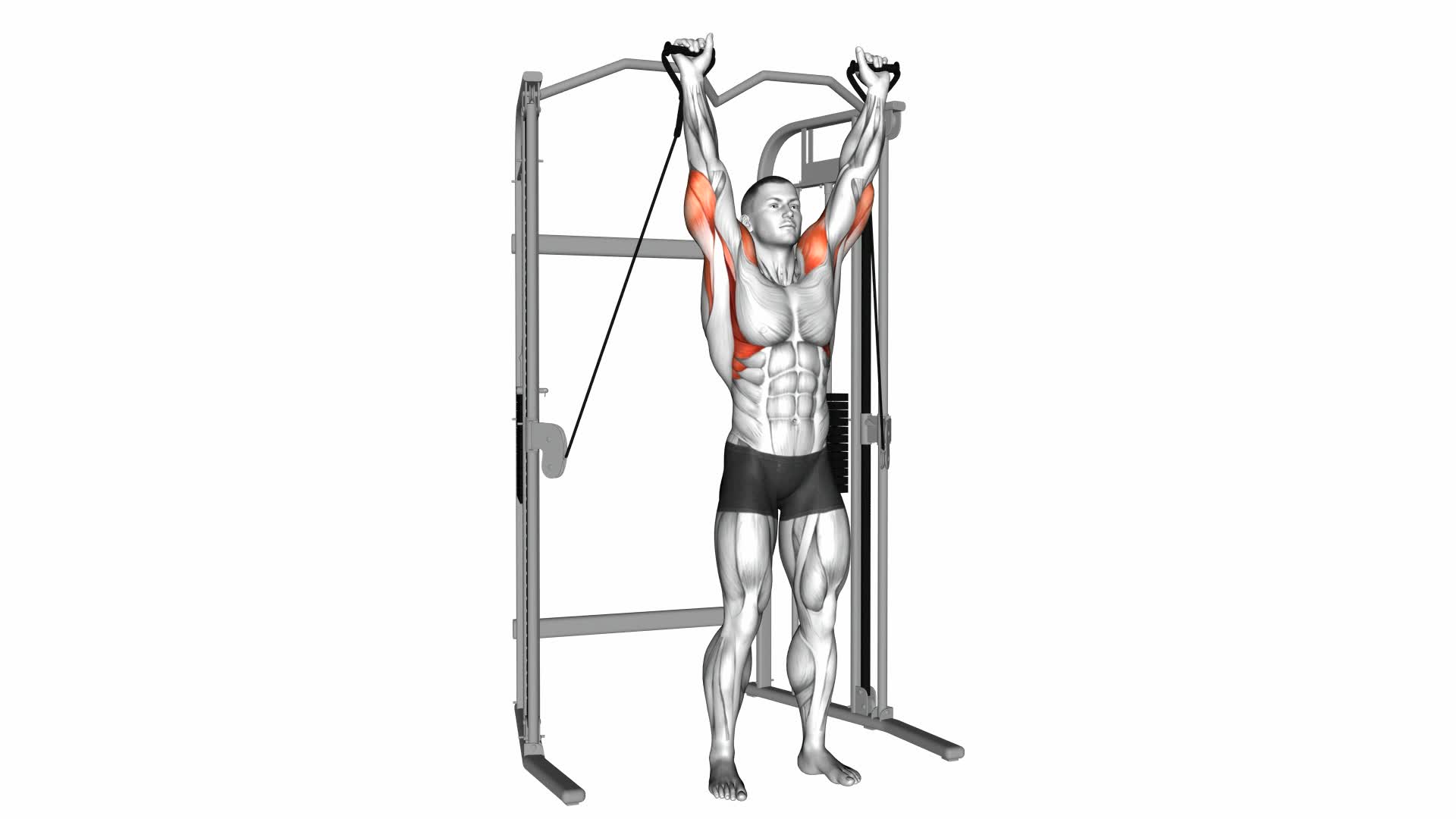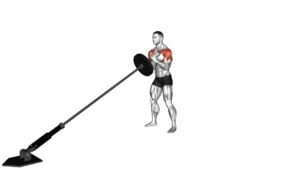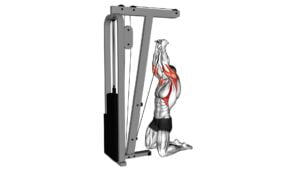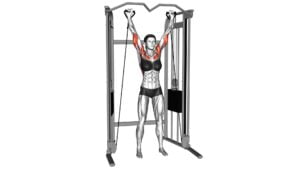Cable Shoulder Press – Video Exercise Guide & Tips

Are you looking to strengthen your shoulders and improve your upper body strength?
Watch This Exercise Video
Then the cable shoulder press is the exercise for you! In this video exercise guide, we'll show you the proper form and technique for performing this exercise, as well as provide tips for maximum shoulder activation.
With variations and modifications available, you can customize your workout to suit your fitness level.
Say goodbye to common mistakes and hello to strong, sculpted shoulders!
Key Takeaways
- Proper form and technique are essential for cable shoulder press, including maintaining a stable stance and engaging core muscles.
- The height of the pulleys on the cable machine should be adjusted to match shoulder height for proper range of motion and safe exercise performance.
- To maximize shoulder activation, warm up and increase shoulder mobility, engage shoulder stabilizer muscles, and maintain proper form with a neutral spine.
- There are variations and modifications for cable shoulder press, such as trying different grips and angles, performing the exercise in seated or standing position, and targeting different parts of the shoulders for variety and challenge.
Proper Form and Technique
To perform the cable shoulder press with proper form and technique, maintain a stable stance and engage your core muscles throughout the exercise. This is important for shoulder stability and to maximize the benefits of the cable shoulder press for overall upper body strength.
Start by standing with your feet shoulder-width apart and a slight bend in your knees. This stable stance will help you maintain balance and prevent any unnecessary strain on your lower back. Engage your core muscles by pulling your belly button towards your spine. This will help stabilize your torso and protect your lower back during the exercise.
Hold the cable handles at shoulder height with your palms facing forward. Begin the exercise by pressing the handles upwards, fully extending your arms without locking your elbows. Keep your shoulders down and back throughout the movement to maintain proper shoulder stability.
As you lower the cable handles back to the starting position, focus on controlling the movement and keeping tension in your shoulder muscles. Avoid letting the weight stack slam down, as this can cause unnecessary stress on your joints.
Setting up the Cable Machine
To set up the cable machine for the cable shoulder press, you'll need to adjust the height of the pulleys to match your shoulder height. This is important because it ensures that you have the proper range of motion and can perform the exercise safely and effectively.
The cable machine is a versatile piece of equipment that allows for a wide variety of exercises targeting different muscle groups. In addition to the cable shoulder press, some common cable machine exercises include cable curls, tricep pushdowns, and cable rows.
One of the benefits of using a cable machine is that it provides constant tension throughout the exercise, which helps to engage and strengthen the muscles more effectively. The cable machine also allows for a greater range of motion compared to other machines or free weights. This can help improve flexibility and joint stability.
Now that you have set up the cable machine, let's move on to some tips for maximum shoulder activation.
Tips for Maximum Shoulder Activation
To maximize shoulder activation during the cable shoulder press, use a proper grip and maintain proper form throughout the exercise. Here are some tips to help you achieve maximum shoulder activation:
- Shoulder Mobility: Before starting the exercise, make sure your shoulders are properly warmed up and have good mobility. Perform some dynamic stretches and rotations to loosen up the muscles and increase range of motion.
- Shoulder Stability: Engage your shoulder stabilizer muscles by keeping your shoulder blades pulled back and down throughout the movement. This will help stabilize the joint and prevent any unnecessary strain on the shoulder.
- Proper Form: Maintain a neutral spine and avoid arching your back or leaning forward during the exercise. This will ensure that the focus remains on the shoulders and prevent any potential injuries.
Variations and Modifications
Try different grips and angles to add variety and challenge to the cable shoulder press exercise. The cable shoulder press can be performed using different equipment options, such as a cable machine or resistance bands. This exercise targets the shoulder muscles, including the deltoids, trapezius, and triceps, while also engaging the core for stability.
One variation you can try is changing the grip. You can use a pronated grip, where your palms are facing down, or a supinated grip, where your palms are facing up. Changing the grip can shift the emphasis on different muscle groups and provide a new stimulus for growth and strength development.
Another variation is adjusting the angle. You can perform the cable shoulder press in a seated position with the cable machine set at shoulder height, or you can perform it in a standing position with the cable machine set at a lower or higher level. Changing the angle can target different parts of the shoulders and challenge your muscles in unique ways.
Incorporating these variations and modifications into your cable shoulder press routine can help prevent plateaus and keep your workouts interesting.
It's important to listen to your body and choose the options that feel comfortable and effective for you. As always, consult with a fitness professional or trainer to ensure proper form and technique.
Common Mistakes to Avoid
When performing the cable shoulder press, be mindful of common mistakes that can hinder your progress and potentially lead to injury. To ensure proper technique and maximize the effectiveness of this exercise, avoid the following common mistakes:
- Using too much weight: It's important to start with a weight that you can comfortably handle, focusing on proper form and control. Using excessive weight can compromise your technique and increase the risk of injury.
- Arching your back: Maintain a neutral spine throughout the exercise, avoiding any excessive arching or leaning backward. This helps to engage the shoulder muscles correctly and prevent strain on the lower back.
- Jerking or using momentum: Avoid using momentum or jerking movements to lift the weight. Instead, focus on a smooth and controlled motion, emphasizing the contraction of the shoulder muscles. This will provide better results and reduce the risk of injury.
Frequently Asked Questions
How Many Sets and Reps Should I Do for the Cable Shoulder Press Exercise?
To determine the number of sets and reps for the cable shoulder press exercise, you need to consider your fitness goals and current fitness level. It's recommended to start with 2-3 sets of 8-12 reps. As you progress, you can increase the number of sets or reps.
This exercise targets the shoulder muscles and can be modified for different fitness levels by adjusting the weight or using different variations. Proper form and technique are crucial for optimal results and to avoid injury.
Can I Perform the Cable Shoulder Press Exercise Using Dumbbells Instead of a Cable Machine?
Yes, you can perform the cable shoulder press exercise using dumbbells instead of a cable machine. This exercise is a variation of the shoulder press, which targets the deltoid muscles.
By using dumbbells, you can still achieve a similar range of motion and engage the shoulder muscles effectively. However, it's important to maintain proper form and start with a weight that's suitable for your fitness level.
Incorporating variations of the shoulder press exercises can help you build strength and improve your shoulder muscles.
Is the Cable Shoulder Press Exercise Suitable for Beginners?
Is it safe for beginners to do the cable shoulder press exercise without supervision?
It's important to have proper form and technique to avoid injury. If you're new to this exercise, it's recommended to start with lighter weights and gradually increase as you gain strength and confidence.
Alternatively, beginners can try other shoulder exercises like dumbbell shoulder press or seated shoulder press machine.
Remember to always consult with a fitness professional before starting any new exercise routine.
What Other Muscles Besides the Shoulders Are Worked During the Cable Shoulder Press Exercise?
During the cable shoulder press exercise, you're not just targeting your shoulders, but also engaging other muscles. This exercise variation works your triceps, upper back, and core muscles.
Incorporating cable exercises into your workout routine offers several benefits. It helps improve stability, increases muscle activation, and allows for a wide range of movement.
Should I Perform the Cable Shoulder Press Exercise Standing or Seated?
To decide whether to perform the cable shoulder press exercise standing or seated, consider the benefits of each form.
Standing engages more core muscles for stability and balance, while seated isolates the shoulder muscles more effectively.
Standing form requires proper posture and control to avoid swinging. Seated form allows for heavier weights and better control.
Choose the form that aligns with your goals and abilities.
Conclusion
In conclusion, performing the cable shoulder press with proper form and technique is essential for maximizing shoulder activation. By setting up the cable machine correctly and following the tips provided, you can ensure a safe and effective workout.
Remember to avoid common mistakes and consider variations and modifications to challenge yourself further. Incorporating the cable shoulder press into your routine can help strengthen and sculpt your shoulder muscles.

Author
Years ago, the spark of my life’s passion ignited in my mind the moment I stepped into the local gym for the first time. The inaugural bead of perspiration, the initial endeavor, the very first surge of endorphins, and a sense of pride that washed over me post-workout marked the beginning of my deep-seated interest in strength sports, fitness, and sports nutrition. This very curiosity blossomed rapidly into a profound fascination, propelling me to earn a Master’s degree in Physical Education from the Academy of Physical Education in Krakow, followed by a Sports Manager diploma from the Jagiellonian University. My journey of growth led me to gain more specialized qualifications, such as being a certified personal trainer with a focus on sports dietetics, a lifeguard, and an instructor for wellness and corrective gymnastics. Theoretical knowledge paired seamlessly with practical experience, reinforcing my belief that the transformation of individuals under my guidance was also a reflection of my personal growth. This belief holds true even today. Each day, I strive to push the boundaries and explore new realms. These realms gently elevate me to greater heights. The unique combination of passion for my field and the continuous quest for growth fuels my drive to break new ground.







